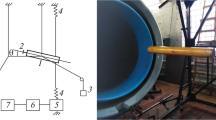Summary
A relation between the damping of a cylinder, suspended from a torsion wire and oscillating around its axis in an infinite viscous fluid, and the coefficient of viscosity of the latter has been deduced. For very thin disks and very weak damping, this relation is the same as that found by some other authors. The theoretical result has been checked by using it for absolute measurements in water, diethylether and air at ordinary temperatures, with disks and cylinders of different sizes, and by comparing the data with those obtained by means of other methods. The agreement proves to be good.
Similar content being viewed by others

Abbreviations
- A :
-
[(1 +Δ 2)1/2 −Δ]1/2
- B :
-
[(1 +Δ 2)1/2 +Δ]1/2
- C1,C2:
-
integration constants
- e :
-
(η -η lit /η lit
- h :
-
thickness of the disk
- H (1) n ,H (2) n :
-
Hankel functions of ordern, respectively of the first and second kind
- i :
-
(−11)½
- I :
-
moment of inertia of the oscillating system
- k :
-
correction factor
- K :
-
elastic constant of the suspension wire
- L :
-
total damping factor in the fluid
- L 0 :
-
damping factor of the suspension wire
- P :
-
i(ϱθ/η)1/2 = (Ai -B/λ
- γ :
-
cylindric coordinate
- R :
-
radius of the disk
- t :
-
time
- T :
-
period of the oscillation in the fluid
- T 0 :
-
period of the oscillation in vacuum
- z :
-
cylindric coordinate
- α(t):
-
angular deflection of the disk at instantt
- Δ :
-
2πΔ = logarithmic decrement of the amplitude in the fluid
- Δ 0 :
-
2πΔ 0 = logarithmic decrement of the amplitude in vacuum
- η :
-
coefficient of viscosity of the fluid
- η 0 :
-
uncorrected value of the coefficient of viscosity
- η lit :
-
mean value of the viscosity coefficient, found in literature
- γ :
-
2π(−Δ+i)/T
- λ :
-
ηT/πϱ)1/2: penetration depth
- π :
-
3.14...
- ϱ :
-
density of the fluid
- τ :
-
T/T 0
- ψ((r, z, t):
-
angular deflection of the fluid at a point (r, z) and at instantt
References
Meyer, O. E., Wied. Ann.32 (1887) 642.
Grossmann, L., Wied. Ann.16 (1882) 619.
König, W., Wied. Ann.32 (1887) 193.
Itterbeek, A. van, Wis- en Natuurk. Tijdschr.6 (1934) 257.
Mac Wood, G. E., Physica5 (1938) 374;5 (1938) 763.
Andronikashvili, E. L., J. Exp. Theor. Phys. U.S.S.R.18 (1948) 429.
Trover, A. de, A. van Itterbeekand G. J. van den Berg, Physica17 (1951) 50.
Hollis Hallet, A. C., Proc. Roy. Soc.A 210 (1952) 404.
Kestin, J., and L. N. Persen, Brown Univ., Physics Div., 1954.
Author information
Authors and Affiliations
Rights and permissions
About this article
Cite this article
Mariens, P., Van Paemel, O. Theory and experimental verification of the oscillating disk method for viscosity measurements in fluids. Appl. sci. Res. 5, 411–424 (1956). https://doi.org/10.1007/BF03184602
Received:
Issue Date:
DOI: https://doi.org/10.1007/BF03184602


